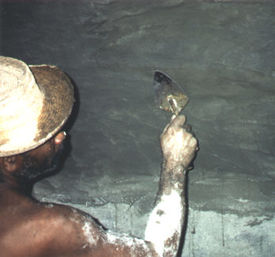Click here to register!
Plasters and Coats for Biogas Digesters and Gas-holder
Overview
| In industrialized countries, most of the new digesters are built of gas-tight concrete or steel. Additives are mixed into the concrete to render it gas-tight. If existing concrete vessels are used, their gas-tightness has to be checked. Often, they have not been built from gas-tight concrete or cracks have formed over time which allow the gas to escape. It is important to check the digester and piping system for gas-tightness prior to putting the biogas unit in service. If leakage is detected only during operation, the digester has to be emptied, cleaned and plastered again. Rectifying a leakage before the initial filling is a lot cheaper. In developing countries, digesters are usually masonry structures. The plastering has to be watertight up to the lowest slurry level and gas-tight from the lowest gas level upwards (gas-holder). The plaster has to resist moisture and temperatures up to 60°C reliably. The plaster must be resistant to organic acid, ammonia and hydrogen sulfide. The undercoat must be absolutely clean and dry. |
 Inside plaster of the gastight section of a fixed dome digester[1] |
Cement Plaster with Special Additives
Good results in water- and gas-tightness have been achieved by adding 'water-proofer' to the cement plaster. For gas-tightness, double the amount of water-proofer is required as compared to the amount necessary for water-tightness. The time between the applications of the layers of plaster should not exceed one day, as the plaster becomes water-tight after one day and the new plaster cannot adhere to the old plaster.
The following 'recipe' from Tanzania guarantees gas-tightness, provided the masonry structure has no cracks:
- layer: cement-water brushing;
- layer: 1 cm cement : sand plaster 1 : 2.5;
- layer: cement-water brushing;
- layer: cement : lime : sand plaster 1 : 0.25 : 2.5;
- layer: cement-water brushing with water-proofer;
- layer: cement : lime : sand plaster with water proofer and fine, sieved sand 1 : 0.25 : 2.5;
- layer: cement screed (cement-water paste) with water-proofer.
The seven courses of plaster should be applied within 24 hours.
A disadvantage of cement plaster is their inability to bridge small cracks in the masonry structure as, for example, bituminous coats can do.
Bitumen (Several Layers)
Bitumen coats can be applied easily and remain elastic over long periods of time. Problems arise in the application as the solvents are inflammable (danger of explosion inside the digester) and a health hazard. Bitumen coats cannot be applied on wet surfaces. The drying of masonry structures requires several weeks, unless some heating device (e.g. a charcoal stove) is placed inside the digester for two to three days. Furthermore, the bituminous coat can be damaged by the up-and-down movement of the slurry.
Bitumen Coat with Aluminum Foil
On the first still sticky bitumen coat, aluminum foil is mounted with generous overlaps. A second layer of bitumen is applied on the aluminum foil. Gas-tightness is usually higher compared to the several layers of bitumen without foil.
Water-thinnable Dispersion Paint
These paints are free from fire- or health hazards. Most of them, however are not gas-tight and not resistant to moisture. Only those dispersion paints should be used which are explicitly recommended for underwater use and which form a gas-tight film.
Single- and Dual Component Synthetic Resin Paints
Synthetic resin paints form elastic, gas-tight coats which can resist rather high physical load. They are comparably expensive, their use seems only justified if the coating has to resist mechanical stress. This is usually the case with fixed dome plants. Measurements have given evidence that the masonry structure of a fixed dome stretches, though minimally, after filling and under gas pressure.
Paraffin
Paraffin, diluted with new engine oil, is warmed up to 100 -150°C and applied on the plaster which has been heated up with a flame-thrower. The paraffin enters into the plaster and effects a 'deep-sealing'. If paraffin is not available, simple candles can be melted and diluted with engine oil.
Further Information
References
- ↑ Kellner (TBW)



















